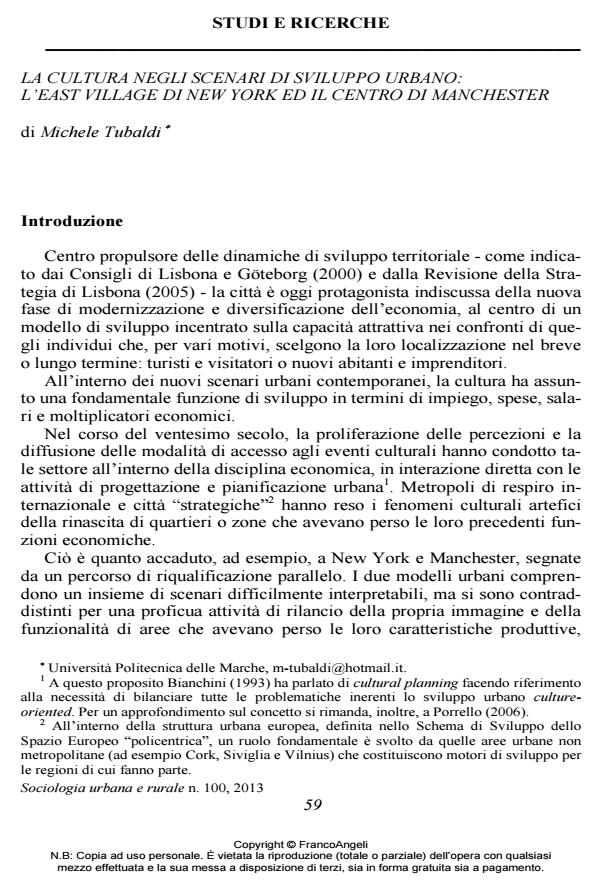Culture in Urban Development Scenarios: the East Village in New York and the Manchester City Centre
Journal title SOCIOLOGIA URBANA E RURALE
Author/s Michele Tubaldi
Publishing Year 2013 Issue 2013/100
Language Italian Pages 15 P. 59-73 File size 224 KB
DOI 10.3280/SUR2013-100005
DOI is like a bar code for intellectual property: to have more infomation
click here
Below, you can see the article first page
If you want to buy this article in PDF format, you can do it, following the instructions to buy download credits

FrancoAngeli is member of Publishers International Linking Association, Inc (PILA), a not-for-profit association which run the CrossRef service enabling links to and from online scholarly content.
The essay investigates the influence of culture on urban land, assessing the socioeconomic impact on cities or quarters involved in local regeneration processes. Two case studies are examined, the East Village neighbourhood of New York City and the city centre of Manchester, considering the data which reveal the socio-economic transformation through the urban benchmarking analysis.
Keywords: Culture, City, Territorial Development, Urban Requalification, Gentrification, Urban Benchmark.
- Freestone R., Gibson C. (2004). City Planner and the Cultural Economy. Intervento alla City Futures Conference. Chicago 8-10 luglio (paper).
- Garcìa B. (2004). Urban regeneration, arts programming and major events, Glasgow 1990, Sydney 2000, Barcelona 2004. International Journal of Cultural Policy, n. 1. DOI: 10.1080/1028663042000212355
- Gruen J. (1990). The New Bohemia. Chicago: Cappella Books
- Hager S. (1986). Art After Midnight: the East Village Scene. New York: St. Martin’s Press
- Haslam D. (2004). Manchester England. In ‘Manchester/Liverpool II, Shrinking Cities, progetto promosso dalla Federal Cultural Foundation, Germany, in collaborazione con la Gallery for Contemporary Art Leipzig, Bauhaus Foundation Dessaue ed il periodico Archplus, testo disponibile al sito: http://www.shrinkingcities.com, 02/2012
- Landry C. (2000). The Creative City. A Toolkit for Urban Innovators. London: Earthscan
- Manchester City Council (2001). Cultural Strategy Consultation Draft. testo disponibile al sito: http://www.manchester.gov.uk, 03/2012.
- Manchester City Council (2006). Annual Survey of Hours and Earnings Resident and Workplace Based Analysis. testo disponibile al sito: http://www.manchester.gov.uk, 03/2012.
- Mele C. (2000). Selling the Lower East Side: Culture, Real Estate, and Resistance in New York City. Minneapolis: University of Minnesota Press.
- Micozzi G. (2002). Marketing della cultura e territorio. Milano: FrancoAngeli
- Misselwitz P. (2004). Manchester - City Profile. In ‘Manchester/Liverpool II, Shrinking Cities, progetto promosso dalla Federal Cultural Foundation, Germany, in collaborazione con la Gallery for Contemporary Art Leipzig, Bauhaus Foundation Dessaue ed il periodico Archplus. Testo disponibile al sito: http://www.shrinkingcities.com, 04/2012.
- New York City Department of City Planning (2008). Final Environmental Impact Statement (FEIS). Testo disponibile al sito: http://www.nyc.gov, 02/2012.
- Porrello A. (2006). L’arte difficile del cultural planning. Venezia: IUAV
- Sacco P.L., Tavano Blessi G. (2005). Distretti culturali evoluti e valorizzazione del territorio. Global and Local Economic Review, n. 8
- Smith N. (1996). The New Urban Frontiers: Gentrification and the Revanchist City. London and New York: Routledge.
- Smith N., Duncan B., Reid L. (1994). From Disinvestment to Reinvestment: Mapping the Urban “Frontier”. In Abu-Lughod J.L., (ed). From Urban Village to East Village. The Battle for New York’s Lower East Side. Oxford UK and Cambridge USA: Basil Blackwell.
- U.S.Department of Commerce (1990 - 2000). Bureau of the Census
- Van Bon S. (1999). The cultural industries: fostering the local in the network economy. A case of study of the Northern quarter in Manchester. Master Thesis European Urban Cultures (POLIS).
- Yigitcanlar T. (2010). A comparative knowledge-based urban development analysis: Vancouver, Melbourne and Manchester vs. Boston. Intervento alla conferenza Proceedings of the 3rd Knowledge Cities World Summit: From Theory to Practice”. Melbourne, Victoria, 16-19 novembre (paper).
- Vicari Haddock S. (2004). La città contemporanea. Bologna: il Mulino.
- Abu-Lughod J.L. (1994). The Changing Economy of the Lower East Side. In Abu-Lughod J.L. (ed). From Urban Village to East Village. The Battle for New York’s Lower East Side. Oxford UK and Cambridge USA: Basil Blackwell
- Abu-Lughod J.L. (1994). (ed). From Urban Village to East Village. Oxford UK and Cambridge USA: Basil Blackwell
- Amendola G. (2009). La città postmoderna. Roma - Bari: Laterza.
- Bianchini F. (1993). Remaking European Cities: the Role of Cultural Policies. In Bianchini F., Parkinson M. (eds). Cultural Policy and Urban Regeneration: the West European Experience. Manchester: Manchester University Press
- Bianchini F., Parkinson M. (1993). (eds). Cultural Policy and Urban Regeneration: the West European Experience. Manchester: Manchester University Press
- Cabodi C., La Greca F., Rota F.S. (2009). (a cura di). Competizione e coesione di Torino in Europa e nel sistema regionale. DITer working papers, n. 31
- Calafati A.G. (2009). Economie in cerca di città. La questione urbana in Italia. Roma: Donzelli
- Chien Lin J. (1994). The Changing Economy of the Lower East Side. In Abu-Lughod J.L. (ed). From Urban Village to East Village. The Battle for New York’s Lower East Side. Oxford UK and Cambridge USA: Basil Blackwell.
- Commissione Europea, Direzione Generale Politica Regionale (2007). Situazione delle città europee. Relazione di sintesi, testo disponibile al sito: http://ec.europa.eu/regional_policy/, 05/2012
- Comunian R., Sacco P.L. (2006). NewcastleGateshead: riqualificazione urbana e limiti della città creativa. Venezia: IUAV
- Da Milano C. (2008). Cultura e integrazione sociale: alcune riflessioni critiche. Economia della Cultura, n. 2.
- Florida R. (2002). The Rise of the Creative Class: and How It’s Transforming Work, Leisure, Community and Everyday Life. New York: Basic Books (trad. it.: L’ascesa della nuova classe creativa. Milano: Mondadori, 2003).
Michele Tubaldi, La cultura negli scenari di sviluppo urbano: l’East Village di New York ed il centro di Manchester in "SOCIOLOGIA URBANA E RURALE" 100/2013, pp 59-73, DOI: 10.3280/SUR2013-100005